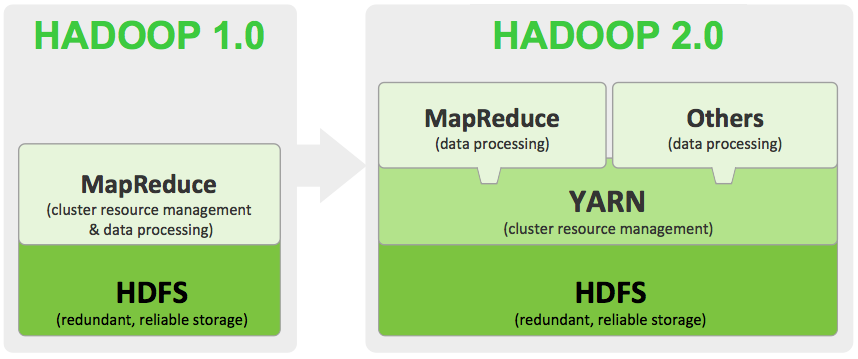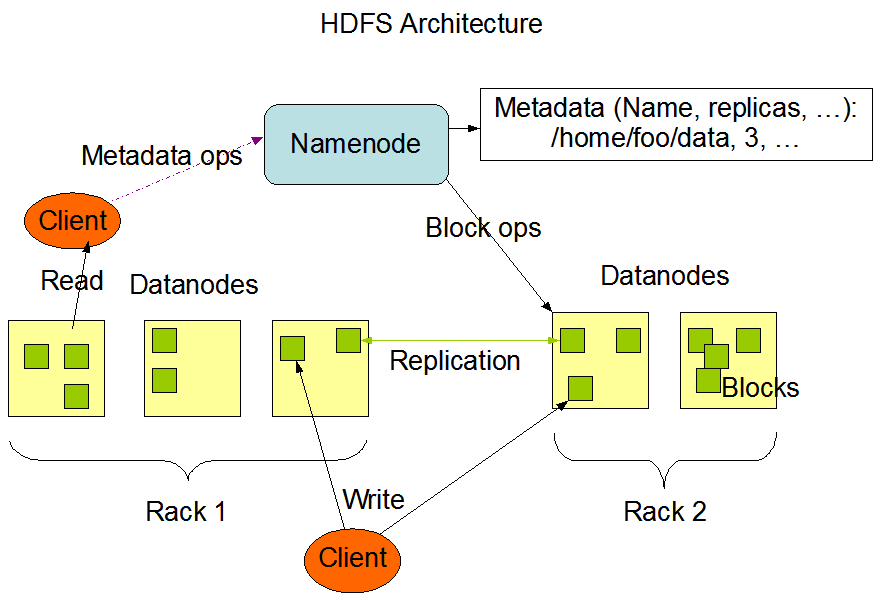Apache™ Hadoop® is an open source software project that enables the distributed processing of large data sets across clusters of commodity servers. It is designed to scale up from a single server to thousands of machines, with a very high degree of fault tolerance. Rather than relying on high-end hardware, the resiliency of these clusters comes from the software’s ability to detect and handle failures at the application layer.
Hadoop 1 popularized MapReduce programming for batch jobs and demonstrated the potential value of large scale, distributed processing. MapReduce, as implemented in Hadoop 1, can be I/O intensive, not suitable for interactive analysis, and constrained in support for graph, machine learning and on other memory intensive algorithms. Hadoop developers rewrote major components of the file system to produce Hadoop 2. To get started with the new version, it helps to understand the major differences between Hadoop 1 and 2.
Hadoop 2: HDFS
HDFS is the Hadoop file system and comprises two major components: namespaces and blocks storage service. The namespace service manages operations on files and directories, such as creating and modifying files and directories. The block storage service implements data node cluster management, block operations and replication.
NameNode and DataNodes
HDFS has a master/slave architecture. An HDFS cluster consists of a single NameNode, a master server that manages the file system namespace and regulates access to files by clients. In addition, there are a number of DataNodes, usually one per node in the cluster, which manage storage attached to the nodes that they run on. HDFS exposes a file system namespace and allows user data to be stored in files. Internally, a file is split into one or more blocks and these blocks are stored in a set of DataNodes. The NameNode executes file system namespace operations like opening, closing, and renaming files and directories. It also determines the mapping of blocks to DataNodes. The DataNodes are responsible for serving read and write requests from the file system’s clients. The DataNodes also perform block creation, deletion, and replication upon instruction from the NameNode.
The NameNode and DataNode are pieces of software designed to run on commodity machines. These machines typically run a GNU/Linux operating system (OS). HDFS is built using the Java language; any machine that supports Java can run the NameNode or the DataNode software. Usage of the highly portable Java language means that HDFS can be deployed on a wide range of machines. A typical deployment has a dedicated machine that runs only the NameNode software. Each of the other machines in the cluster runs one instance of the DataNode software. The architecture does not preclude running multiple DataNodes on the same machine but in a real deployment that is rarely the case.
The existence of a single NameNode in a cluster greatly simplifies the architecture of the system. The NameNode is the arbitrator and repository for all HDFS metadata. The system is designed in such a way that user data never flows through the NameNode.
Data Replication
HDFS is designed to reliably store very large files across machines in a large cluster. It stores each file as a sequence of blocks; all blocks in a file except the last block are the same size. The blocks of a file are replicated for fault tolerance. The block size and replication factor are configurable per file. An application can specify the number of replicas of a file. The replication factor can be specified at file creation time and can be changed later. Files in HDFS are write-once and have strictly one writer at any time.
The NameNode makes all decisions regarding replication of blocks. It periodically receives a Heartbeat and a Blockreport from each of the DataNodes in the cluster. Receipt of a Heartbeat implies that the DataNode is functioning properly. A Blockreport contains a list of all blocks on a DataNode.
Hadoop 2: YARN
As part of Hadoop 2.0, YARN(Yet Another Resource Neogitator) takes the resource management capabilities that were in MapReduce and packages them so they can be used by new engines. This also streamlines MapReduce to do what it does best, process data. With YARN, you can now run multiple applications in Hadoop, all sharing a common resource management. Many organizations are already building applications on YARN in order to bring them IN to Hadoop.
When enterprise data is made available in HDFS, it is important to have multiple ways to process that data. With Hadoop 2.0 and YARN organizations can use Hadoop for streaming, interactive and a world of other Hadoop based applications.
Apache Hadoop YARN joins Hadoop Common (core libraries), Hadoop HDFS (storage) and Hadoop MapReduce (the MapReduce implementation) as the sub-projects of the Apache Hadoop which, itself, is a Top Level Project in the Apache Software Foundation. Until this milestone, YARN was a part of the Hadoop MapReduce project and now is poised to stand up on it’s own as a sub-project of Hadoop.
What YARN Does
YARN enhances the power of a Hadoop compute cluster in the following ways:
- Scalability
The processing power in data centers continues to grow quickly. Because YARN ResourceManager focuses exclusively on scheduling, it can manage those larger clusters much more easily. - Compatibility with MapReduce
Existing MapReduce applications and users can run on top of YARN without disruption to their existing processes. - Improved cluster utilization.
The ResourceManager is a pure scheduler that optimizes cluster utilization according to criteria such as capacity guarantees, fairness, and SLAs. Also, unlike before, there are no named map and reduce slots, which helps to better utilize cluster resources. - Support for workloads other than MapReduce
Additional programming models such as graph processing and iterative modeling are now possible for data processing. These added models allow enterprises to realize near real-time processing and increased ROI on their Hadoop investments. - Agility
With MapReduce becoming a user-land library, it can evolve independently of the underlying resource manager layer and in a much more agile manner.
How YARN Works
The fundamental idea of YARN is to split up the two major responsibilities of the JobTracker/TaskTracker into separate entities:
- a global ResourceManager
- a per-application ApplicationMaster.
- a per-node slave NodeManager and
- a per-application Container running on a NodeManager
The ResourceManager and the NodeManager form the new, and generic, system for managing applications in a distributed manner. The ResourceManager is the ultimate authority that arbitrates resources among all the applications in the system. The per-application ApplicationMaster is a framework-specific entity and is tasked with negotiating resources from the ResourceManager and working with the NodeManager(s) to execute and monitor the component tasks. The ResourceManager has a scheduler, which is responsible for allocating resources to the various running applications, according to constraints such as queue capacities, user-limits etc. The scheduler performs its scheduling function based on the resource requirements of the applications. The NodeManager is the per-machine slave, which is responsible for launching the applications’ containers, monitoring their resource usage (cpu, memory, disk, network) and reporting the same to the ResourceManager. Each ApplicationMaster has the responsibility of negotiating appropriate resource containers from the scheduler, tracking their status, and monitoring their progress. From the system perspective, the ApplicationMaster runs as a normal container.



The Disqus comment system is loading ...
If the message does not appear, please check your Disqus configuration.